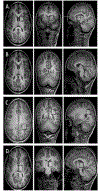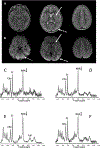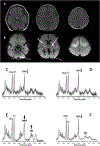Brain MR imaging and spectroscopy for outcome prognostication after pediatric cardiac arrest
- PMID: 32653571
- PMCID: PMC7769908
- DOI: 10.1016/j.resuscitation.2020.06.033
Brain MR imaging and spectroscopy for outcome prognostication after pediatric cardiac arrest
Abstract
Aim: Children surviving cardiac arrest are at high risk of neurological morbidity and mortality; however, there is a lack of validated prognostic biomarkers. We aimed to evaluate brain magnetic resonance imaging (MRI) and spectroscopy (MRS) as predictors of death and disability. Secondly, we evaluated whether MRI/S by randomized group.
Methods: This single center study analyzed clinically indicated brain MRI/S data from children enrolled in a randomized controlled trial of 24 vs. 72 h of hypothermia following cardiac arrest. Two pediatric radiologists scored conventional MRIs. Lactate and N-acetyl-aspartate (NAA) concentrations (mmol/kg) were determined from spectra acquired from the basal ganglia, thalamus, parietal white matter and parietooccipital gray matter. Mortality and neurological outcomes (favorable = Pediatric Cerebral Performance Category [PCPC] 1, 2, 3 or increase < 2) were assessed at hospital discharge. Non-parametric tests were used to test for associations between MRI/S biomarkers and outcome and randomized group.
Results: 23 children with (median [interquartile range]) age of 1.5 (0.3-4.0) years. Ten (44%) had favorable outcome. There were more T2 brain lesions in the lentiform nuclei in children with unfavorable 12 (92%) vs. favorable 3 (33%) outcome, p = 0.007. Increased lactate and decreased NAA concentrations in the parietooccipital gray matter and decreased NAA in the parietal white matter were associated with unfavorable outcome (p's < 0.05). There were no differences for any biomarker by randomized group.
Conclusion: Regional cerebral and metabolic MRI/S biomarkers are predictive of neurological outcomes at hospital discharge in pediatric cardiac arrest and should undergo validation testing in a large sample.
Trial registration: ClinicalTrials.gov NCT00797680.
Keywords: Cardiac arrest; Magnetic resonance imaging; Magnetic resonance spectroscopy; Outcome; Pediatric; Prognostication.
Copyright © 2020 Elsevier B.V. All rights reserved.
Conflict of interest statement
Figures




Comment in
-
MRI/MRS for prognosis in pediatric cardiac arrest: Worth a deeper dive.Resuscitation. 2020 Dec;157:259-260. doi: 10.1016/j.resuscitation.2020.07.028. Epub 2020 Oct 17. Resuscitation. 2020. PMID: 33080370 No abstract available.
Similar articles
-
Assessment of Brain Magnetic Resonance and Spectroscopy Imaging Findings and Outcomes After Pediatric Cardiac Arrest.JAMA Netw Open. 2023 Jun 1;6(6):e2320713. doi: 10.1001/jamanetworkopen.2023.20713. JAMA Netw Open. 2023. PMID: 37389874 Free PMC article.
-
Prognostic Value of Brain Magnetic Resonance Imaging in Children After Out-of-Hospital Cardiac Arrest: Predictive Value of Normal Magnetic Resonance Imaging for a Favorable Two-Year Outcome.Pediatr Neurol. 2025 Apr;165:96-104. doi: 10.1016/j.pediatrneurol.2025.01.023. Epub 2025 Feb 3. Pediatr Neurol. 2025. PMID: 39987637
-
Association of MRI Brain Injury With Outcome After Pediatric Out-of-Hospital Cardiac Arrest.Neurology. 2021 Feb 2;96(5):e719-e731. doi: 10.1212/WNL.0000000000011217. Epub 2020 Nov 18. Neurology. 2021. PMID: 33208547 Free PMC article.
-
Imaging for Neuroprognostication After Cardiac Arrest: Systematic Review and Meta-analysis.Neurocrit Care. 2020 Feb;32(1):206-216. doi: 10.1007/s12028-019-00842-0. Neurocrit Care. 2020. PMID: 31549351
-
Brain imaging in comatose survivors of cardiac arrest: Pathophysiological correlates and prognostic properties.Resuscitation. 2018 Dec;133:124-136. doi: 10.1016/j.resuscitation.2018.09.012. Epub 2018 Sep 19. Resuscitation. 2018. PMID: 30244045 Review.
Cited by
-
Early Blood Biomarkers and MRI Injury After Cardiac Arrest: Secondary Analysis of the 2017-2020 Personalized Outcomes After Child Cardiac Arrest Study.Pediatr Crit Care Med. 2025 Jul 1;26(7):e915-e923. doi: 10.1097/PCC.0000000000003756. Epub 2025 Apr 28. Pediatr Crit Care Med. 2025. PMID: 40293338
-
Use of Magnetic Resonance Imaging in Neuroprognostication After Pediatric Cardiac Arrest: Survey of Current Practices.Pediatr Neurol. 2022 Sep;134:45-51. doi: 10.1016/j.pediatrneurol.2022.06.011. Epub 2022 Jun 20. Pediatr Neurol. 2022. PMID: 35835025 Free PMC article.
-
Practice patterns for acquiring neuroimaging after pediatric in-hospital cardiac arrest.Resuscitation. 2025 Feb;207:110506. doi: 10.1016/j.resuscitation.2025.110506. Epub 2025 Jan 21. Resuscitation. 2025. PMID: 39848427 Clinical Trial.
-
Assessment of the Effects of Sodium Nitroprusside Administered Via Intracranial Subdural Catheters on the Cerebral Blood Flow and Lactate Using Dynamic Susceptibility Contrast Magnetic Resonance Imaging and Proton Magnetic Resonance Spectroscopy in a Pig Cardiac Arrest Model.J Am Heart Assoc. 2023 Oct 3;12(19):e029774. doi: 10.1161/JAHA.123.029774. Epub 2023 Sep 30. J Am Heart Assoc. 2023. PMID: 37776216 Free PMC article.
-
Assessment of Brain Magnetic Resonance and Spectroscopy Imaging Findings and Outcomes After Pediatric Cardiac Arrest.JAMA Netw Open. 2023 Jun 1;6(6):e2320713. doi: 10.1001/jamanetworkopen.2023.20713. JAMA Netw Open. 2023. PMID: 37389874 Free PMC article.
References
-
- Nolan JP, Neumar RW, Adrie C, et al. Post-cardiac arrest syndrome: epidemiology, pathophysiology, treatment, and prognostication: a scientific statement from the International Liaison Committee on Resuscitation; the American Heart Association Emergency Cardiovascular Care Committee; the Council on Cardiovascular Surgery and Anesthesia; the Council on Cardiopulmonary, Perioperative, and Critical Care; the Council on Clinical Cardiology; the Council on Stroke (Part II). Int Emerg Nurs. 2010;18(1):8–28. - PubMed
Publication types
MeSH terms
Associated data
Grants and funding
LinkOut - more resources
Full Text Sources
Medical

